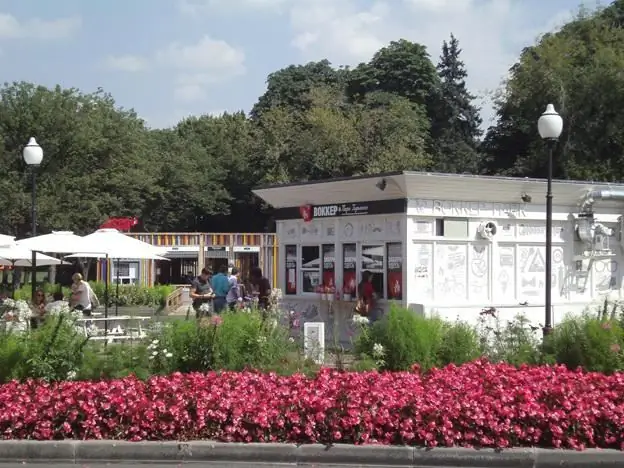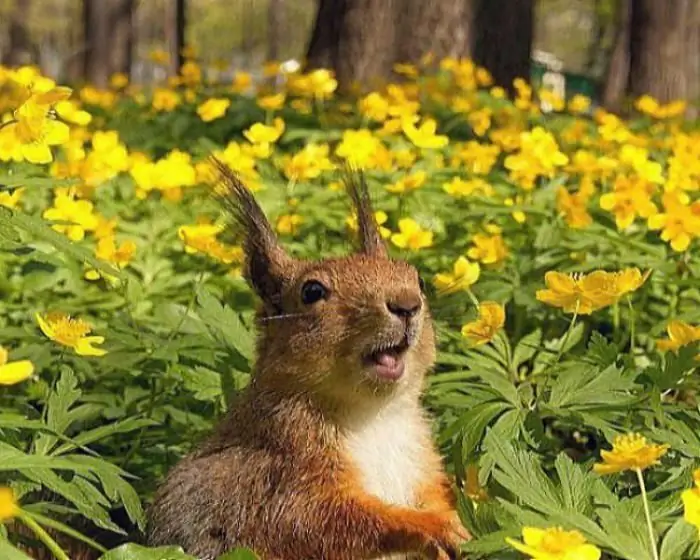- Author Harold Hamphrey [email protected].
- Public 2023-12-17 10:06.
- Last modified 2025-01-24 11:10.
Until the beginning of the 19th century, the territory that today is occupied by the Gorky Central Park of Culture and Leisure was located outside the city. Today it is the center of the capital, a favorite vacation spot for Muscovites.
In this calm and picturesque place, located on the banks of the Moskva River, everyone will find a sparsely populated corner where you can hide from the hustle and bustle of the city, go boating or stroll along the alleys of the Neskuchny Garden.

Gorky Central Park of Culture and Leisure: History
Once on this land was the estate of Prince Trubetskoy, which was famous not only for its majestic buildings, but also for its botanical garden, where the high society of Moscow enjoyed spending time.
In 1923, the All-Russian Agricultural Exhibition was held next to this garden. It was at this time that it was decided to create on the territory of the exhibition, the Sparrow Hills and the Neskuchny Garden an “Outdoor Culture Combine”. This is how the first park of the Soviet period appeared, which was intended for organizing the leisure of the population, maintainingpolitical and educational and cultural and educational work.

In March 1928, the Moscow government decided to create the Central Park of Culture and Leisure on the territory of the former All-Union Agricultural Exhibition. For this purpose, a construction commission was created, which received many proposals from citizens. Some believed that this park should be equipped with everything necessary for recreation. “The central green area should be given to athletes!” others argued. There were many opinions. Someone wanted the Central Park of the city to be the venue for music competitions and concerts. Muscovites not only heatedly discussed what it would be like, but also created it with their own hands. On subbotniks, they broke paths, dismantled unnecessary buildings, rammed sites, uprooted stumps, etc.
Opening
The park was officially opened in August 1928. The capital's newspapers the day before (August 11, 1928) invited everyone here to be citizens. They reported that on the opening day the entrance to the park would be free, and then the cost would be 10 kopecks. In addition, seasonal tickets were issued, the price of which was 50 kopecks.
The opening was an international event. Nowhere in the world has a park been created for working people yet. The Central Cultural and Entertainment Complex attracted the attention of the foreign press.

Park layout
Moscow constructivist K. Melnikov was appointed the chief architect of the building being created. To himbelongs to the idea of the layout of the parterre, which has survived to our time. She replaced the one designed by architect I. V. Zholtovsky during preparations for the All-Russian Exhibition.
Melnikov planned to install a fountain in the center of the stalls, in which, according to him, the architecture was supposed to be formed by jets of water. His project was not realized. In the mid-thirties, on the site that Melnikov allotted for its construction, a fountain of a completely different nature was created, designed by the architect A. V. Vlasov.
The Central Park of Moscow began to be built up with the first exhibition and sports pavilions. A decorative pool, attractions and a children's playground also appeared. In 1932 it got its name - Gorky Central Park.
Betty Glan
The name of this woman is inscribed in golden letters in the history of the park. Betty Glan was its first director (1929-1937). This time is often referred to by historians as the "golden age" of the park. In the 1920s, it was often referred to as "a cultural plant for the alteration of consciousness."
In 1929, the reconstruction of the park continued. Architect Rodrigo Dacosta (Brazil) restored the Handicrafts Pavilion (current administration) and housed a sound cinema. It became truly legendary and the most popular in Moscow and worked until the war itself, but a bomb destroyed it in 1942.

A lot of rides have appeared in the park. Especially popular was the 35-meter parachute tower with a spiral descent,located near the Moscow River. Visitors used to slide down it using special rugs.
The main part of the rides was located between the Shestahedron and Pioneer Pond. The Hexagon Pavilion is a restaurant with tables around a fountain in the courtyard. The park regularly hosts a wide variety of activities. Increasingly, the central park was called a "cultural combine", "green university", "propagandist of a new way of life", "weekend school", etc.
Under the leadership of Betty Glan, he became known throughout the world, turned into a symbol of the new socialist state.
In 1937, Betty was arrested after her husband. She spent seventeen long years in the camps, but survived and was rehabilitated in 1954. After her release, she worked for a long time in the Union of Composers. Her book of memoirs was published in 1988. In 2008, when Gorky Central Park celebrated its 85th anniversary, Betty Glan's book was republished again.
Park Development
Muscovites immediately fell in love with this park. The central garden and park complex of the city has become a favorite place for their recreation. Gradually, they began to appear here: Leninskaya Square, the Bolshoi and Maly Theaters, a children's town, "Spiral Descent" (attraction), etc.
A military town, a symphonic stage were created in the Neskuchny Garden, a "Corner of Silence" was created in the Golitsyn Park. The hunting and bath lodges have turned into tea-snack bars - "Samovarnik" and "Float". The southern part of the Neskuchny Garden (behind the Andreevsky ravine) was taken under the town of a one-dayrecreation. Here, in addition to the residential building, there was a private park with paths, lawns and flower beds, dance and sports grounds, a music and film stage, a reading room and various attractions.

Gorky Park today
As already mentioned, the development project for this wonderful park area, stretching for seven kilometers along the Moskva River, was developed by a group of architects led by avant-garde artist K. S. Melnikov. It should be noted that the layout has been preserved almost in its original form to our time.

The huge Triumphal Gates are the entrance to the park from the Krymsky Val. There is also an entrance from the embankment (near the Andreevsky bridge), as well as from Leninsky Prospekt. The Central Park covers an area of 109 hectares. It can be divided into two zones - the Neskuchny Garden and the ground floor. The center of the latter is decorated with a magnificent musical fountain, where Muscovites and guests of the capital like to relax. There are many small fountains throughout the territory.
An impressive part of the park is occupied by the Golitsin ponds (half a hectare) and several smaller ponds, which are surrounded by rose gardens and flower beds. The Golitsinsky pond can be divided into two parts: swans and ducks swim on one of them all summer long, the second part is intended for riding catamarans and boats.
To the west of the park is the Green Theatre, which was built in 1928 and renovated in the late sixties. Today there arevarious concerts and competitions. Behind it begins Pushkinskaya Embankment and the magnificent Neskuchny Garden. The park has free Wi-Fi, excellent bike paths, a rope town for children "Panda Park", playgrounds and much more.
Entertainment
Today, Muscovites, Russian and foreign tourists enjoy visiting Gorky Park. The central cultural and entertainment complex of the capital attracts people with its magnificent landscape and a variety of entertainment for both children and adults.
From Pushkinskaya Embankment you can go on an exciting three-hour journey along the Moscow River on the Radisson Royal Moscow yacht. The Pioneer summer cinema operates under the open sky. Here you can watch famous Soviet films.

Sports
Central Park (the city of Moscow) retains its sports orientation, laid down in the years of its creation, to this day. There is a running center and yoga classes. Table tennis lovers will love Ping-Pong Park, and the modern tennis court with a professional surface meets European standards. There are fields for beach volleyball and football. In the park you can rent a velomobile or roller skates, a scooter or a bicycle and other sports equipment.
Many Muscovites look forward to the opening every year in the Gorky Skating Rink Park with artificial ice and luxurious lighting. It operates from November to March. It should be noted that the coating can withstand even positive temperatures. itthe largest ice rink in Europe - its area is eighteen thousand square meters.

Fans of extreme sports appreciated the artificial slide for snowboarders. This is the largest such structure in the world. It was built according to a unique project. The track is made up of zones for beginner snowboarders and experienced masters. Artificial turf keeps the slide running all winter.
Culture
The park operates "Garage" - the center of modern culture. Its main task is to promote contemporary art. The pavilion regularly hosts demonstrations of experimental works by emerging artists and exhibitions, film screenings and lectures.

Are there rides in the park?
Today there are no rides in the park, they were dismantled in 2011. Instead, there are many interesting places for kids. One of them is the Green School. Here the kids get acquainted with the heroes of children's cartoons and fairy tales, for them the club with the funny name "Mamalysh" has opened its doors.
Older children will be interested in visiting a mini-zoo or squirrel cage. Here you can feed the animals with treats bought from special vending machines.
Teenagers enjoy visiting the People's Observatory, which was established in 1929. It has been reconstructed and today welcomes visitors again. The dome of the observatory rotates 360 degrees. It has a telescope that magnifies the heavenly bodies 840 times. At the observatoryfree lectures are held by leading employees of the main planetarium of Moscow.
Restaurants and cafes
There are a lot of such establishments in the park. For example, in the restaurant by the river "Vremena Goda" you can taste delicious dishes of Russian and European cuisine (black cod fillet, for example). Pelman cafe offers a portion of fragrant hot dumplings with fillings for every taste. For lovers of light desserts, we recommend that you go to the Fruit Bar, where you will be treated to an original fruit salad.
How to get to Central Park?
You can get to the wonderful entertainment complex from the Park Kultury metro station. The journey will take you no more than ten minutes.






